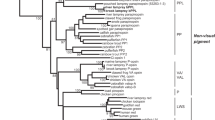Play all audios:

ABSTRACT IN 1936 Young1 described a structure in several genera of octopods (cephalopods) appearing on the ventral surface of both stellate ganglia (near the base of the stellar nerve most
distal to the mantle connective) which he termed the “epistellar body”. From histological considerations he hypothesized that this body might have a neurosecretory function. Nishioka _et
al._2 reinvestigated this structure in _Octopus_ in more detail and, by electron microscopy, made the significant observation that the epistellar body contains cells the surfaces of which
display microvilli suggesting rhabdomeric structures as seen typically in molluscan and arthropod visual photoreceptors. Later Nishioka _et al._3 extended their investigations to include
_Eledone moschata_ and presented not only further electron micrograph data on the rhabdomeric ultrastructure but also biochemical data indicating the presence of a rhodopsin photopigment.
Thus these investigators argued that the neurone-like cells of the epistellar body could be photo-receptors. We present here electrophysiological evidence clearly indicating the presence of
photoreceptor cells in the epistellar body. There is already electrophysiological evidence for extracellular photoreceptors in arthropods4–7, molluscs8,9 and for photoreceptors in the
diencephalon of the frog10,11. Access through your institution Buy or subscribe This is a preview of subscription content, access via your institution ACCESS OPTIONS Access through your
institution Subscribe to this journal Receive 51 print issues and online access $199.00 per year only $3.90 per issue Learn more Buy this article * Purchase on SpringerLink * Instant access
to full article PDF Buy now Prices may be subject to local taxes which are calculated during checkout ADDITIONAL ACCESS OPTIONS: * Log in * Learn about institutional subscriptions * Read our
FAQs * Contact customer support SIMILAR CONTENT BEING VIEWED BY OTHERS THE NON-VISUAL OPSINS EXPRESSED IN DEEP BRAIN NEURONS PROJECTING TO THE RETINA IN LAMPREYS Article Open access 15 June
2020 ANATOMY OF SUPERIOR OLIVARY COMPLEX AND LATERAL LEMNISCUS IN ETRUSCAN SHREW Article Open access 26 June 2024 THE NERVOUS SYSTEM OF THE MOST COMPLEX LOPHOPHORE PROVIDES NEW INSIGHTS
INTO THE EVOLUTION OF BRACHIOPODA Article Open access 10 August 2021 REFERENCES * Young, J. Z., _Quart. J. Microsc. Sci._, 78, 311 (1936). Google Scholar * Nishioka, R. S., Hagedorn, I. R.,
and Bern, H. A., _Z. Zellforsch._, 57, 406 (1962). Article CAS Google Scholar * Nishioka, R. S., Yasamasu, Y., Packard, A., Bern, H. A., and Young, J. Z., _Z. Zellforsch._, 75, 301
(1966). Article CAS Google Scholar * Kennedy, D., _J. Gen. Physiol._, 46, 551 (1963). Article CAS Google Scholar * Gwilliam, G. F., _Biol. Bull._, 125, 470 (1963); 129, 244 (1965).
Article Google Scholar * Millecchia, R., Bradbury, J., and Mauro, A., _Science_, 154, 1199 (1966). Article ADS CAS Google Scholar * Zwicky, K. T., _Life Sci._, 7, 257, Part II (1968).
Article CAS Google Scholar * Arvanitaki, A., and Chalazonitis, N., in _Nervous Inhibition_ (edit. by Florey, E.), 194 (Pergamon, 1961). Google Scholar * Kennedy, D., _J. Gen. Physiol._,
44, 277 (1960). Article CAS Google Scholar * Dodt, E., and Jacobson, M., _J. Neurophysiol._, 26, 752 (1963). Article CAS Google Scholar * Dodt, E., and Morita, Y., _Vision Res._, 4,
413 (1964). Article CAS Google Scholar * Boycott, B. B., and Young, J. Z., in _Bertil Hanström_ (edit. by Wingstrand, K. G.) (Lund Zool. Inst., 1959). Google Scholar * Haefilfinger, H.
R., _Rev. Suisse de Zool._, 61, 153 (1954). Article Google Scholar * Messenger, J. B., _Nature_, 213, 836 (1967). Article ADS CAS Google Scholar * Nishioka, R. S., Simpson, L., and
Bern, H. A., _Veliger_, 7, 1 (1964). Google Scholar * Simpson, L., Bern, H. A., and Nishioka, R. S., _Gen. Comp. Endocrinol._, 7, 525 (1966). Article CAS Google Scholar Download
references AUTHOR INFORMATION Author notes * ALEXANDER MAURO Present address: Rockefeller University, New York AUTHORS AND AFFILIATIONS * Zoological Station, Naples ALEXANDER MAURO &
FRITZ BAUMANN * Institute of Physiology, University of Geneva, Switzerland FRITZ BAUMANN Authors * ALEXANDER MAURO View author publications You can also search for this author inPubMed
Google Scholar * FRITZ BAUMANN View author publications You can also search for this author inPubMed Google Scholar RIGHTS AND PERMISSIONS Reprints and permissions ABOUT THIS ARTICLE CITE
THIS ARTICLE MAURO, A., BAUMANN, F. Electrophysiological Evidence of Photoreceptors in the Epistellar Body of _Eledone moschata_. _Nature_ 220, 1332–1334 (1968).
https://doi.org/10.1038/2201332a0 Download citation * Received: 16 October 1968 * Revised: 14 November 1968 * Issue Date: 28 December 1968 * DOI: https://doi.org/10.1038/2201332a0 SHARE THIS
ARTICLE Anyone you share the following link with will be able to read this content: Get shareable link Sorry, a shareable link is not currently available for this article. Copy to clipboard
Provided by the Springer Nature SharedIt content-sharing initiative
